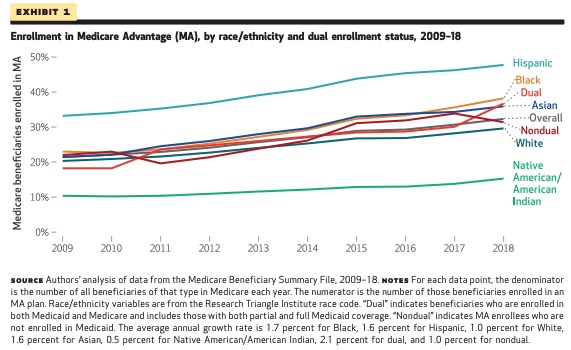
From 2009 to 2018, enrollment in the Medicare Advantage program grew rapidly, with the largest increases concentrated among minority populations, according to a new study published in Health Affairs.
In 2009, 23% of Black Medicare beneficiaries were in a Medicare Advantage plan, as compared to 38% in 2018 — representing a 66% relative increase. Similarly, the percentage of Hispanic beneficiaries in those plans jumped from 33% to 48% in the same decade, a 43% relative increase.
In addition, the proportion of dual enrollees in Medicare Advantage plans increased from 18% in 2009 to 37% in 2018, a 101% relative increase. Dual enrollees are beneficiaries who are enrolled in both Medicare and Medicaid plans.
Comparatively, there was a 46% spike among White beneficiaries in a Medicare Advantage plan within the same decade, and a 43% increase among non-dual enrollees. [Click image to enlarge]

A Deep-dive Into Specialty Pharma
A specialty drug is a class of prescription medications used to treat complex, chronic or rare medical conditions. Although this classification was originally intended to define the treatment of rare, also termed “orphan” diseases, affecting fewer than 200,000 people in the US, more recently, specialty drugs have emerged as the cornerstone of treatment for chronic and complex diseases such as cancer, autoimmune conditions, diabetes, hepatitis C, and HIV/AIDS.
The study’s authors examined enrollment and demographic information contained in the Medicare Master Beneficiary Summary File 2009-18. For information on Medicare Advantage plan characteristics, including Special Needs Plan type, premiums and star ratings, researchers used publicly reported data from the Centers for Medicare & Medicaid Services.
While the study was not commissioned, it was funded by the National Institute on Aging.
Along with the growth in minority enrollment, the study found that minority beneficiaries were concentrated in specific plans, said David J. Meyers, assistant professor at the Brown University School of Public Health, in an email.
This also proved to be the most surprising finding for study authors.
“While we expected there to be some variation, we were surprised at how much minority beneficiaries tended to enroll in specific plans,” Meyers said. “Hispanic and Asian beneficiaries in particular tended to enroll in plans with very high concentrations of other Hispanic and Asian beneficiaries, respectively.”
Further, Meyers and his colleagues found that minority populations were more likely to enroll in plans of lower quality. About 70% of White beneficiaries were in plans rated with four or five stars compared with around 55% of Black, 60% of Hispanic, 42% of Asian and 54% of Native American/American Indian enrollees.
Overall, the study shows “high and growing enrollment of Black and Hispanic enrollees in Medicare Advantage,” study authors wrote. If current trends continue, the majority of Black, Hispanic and dual enrollee Medicare beneficiaries will be in a Medicare Advantage plan within the next five years.
For payers, the key takeaway from this study is that the high rates of minority enrollment indicate they will need to play an important role in addressing health inequities, Meyers said.
“As this enrollment continues, it will be important for payers to ensure they are providing high-quality care and meeting each of their beneficiaries’ unique needs,” he said.
Photo: shapecharge, Getty Images, Health Affairs














